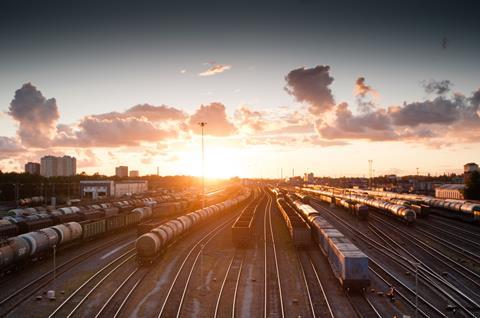
GERMANY: Driverless shunting locomotives are expected to be operating in commercial service at DB Cargo’s München-Nord marshalling yard by the end of 2024, following the award of contracts for the development of onboard systems for both train positioning and ATO.
DB Cargo has appointed Augsburg-based Railergy to lead the development and retrofitting of onboard equipment to hump shunting locomotives for unattended operation to Grade of Automation 4, including the use of artificial intelligence.
Many of DB Cargo’s shunters are already fitted with radio remote control, allowing them to be driven using a beltpack. The company has also trialled ‘semi-automatic’ shunting to GoA2, in order to improve the competitiveness and efficiency of its wagonload freight operations.
The project announced on October 25 aims to develop a GoA4 package that can be retrofitted to various types of locomotive, allowing full automation of the hump shunting process. Key steps include the automation of simple activities such as pushing wagon cuts up to the yard hump, clearing the reception tracks, retrieving false runners and shunting beyond the hump.

The trial will initially be carried out using an existing Class 296 diesel shunter, but GoA4 operation is also expected to be implemented on a modern hybrid locomotive. While the initial project will focus on marshalling operations, the system will be developed with an eye to future extension to other shunting tasks, such as those in freight terminals and ports.
Two levels of accuracy
Railergy has extensive experience in the development and installation of onboard systems for both vehicle positioning and remote control. The company’s range include a modular TCMS which can be retrofitted to existing locomotives and railcars, providing interfaces for digital systems including ETCS and ATO. It has also developed a 5G-based remote control system in conjunction with Thales Germany.
The principal functions for the onboard automation package include determination of the locomotive’s exact position within the marshalling yard, precise control of the traction and braking, monitoring of speed and safe operating range, and the detection of signals and any obstacles.
An inertial measurement unit will be used to determine the locomotive’s position without the need for fixed trackside equipment such as balises. By constantly comparing the locomotive’s movement with a precise infrastructure map and known landmarks such as signals and buildings, this will provide reliable positioning to an accuracy of ±3 m, which is deemed sufficient for train protection. The system will be supplemented by GNSS satellite location to a more precise accuracy of ±500 mm for fine control.
Obstacle and signal detection will follow a similar concept: objects must be detected reliably using approvable measurement and evaluation procedures to ensure safe operation, but artificial intelligence will be used in parallel to increase productivity.
Approvability will be achieved by continuously monitoring the AI-based functionality using the safe object detection. However, Railergy says there will also be scope to develop innovative validation and testing procedures for the AI software applications, where there are currently no recognised approval processes.
Railergy will work on the project with a range of other suppliers, including Bachleitner Technology which will provide the safe computer platform and cameras, Ouster will supply 3D lidar sensors, and ParkVi the image processing functions. GNSS/INS location technology will be supplied by Applanix, while Systerel SAS will assist with safety and approval support.

















